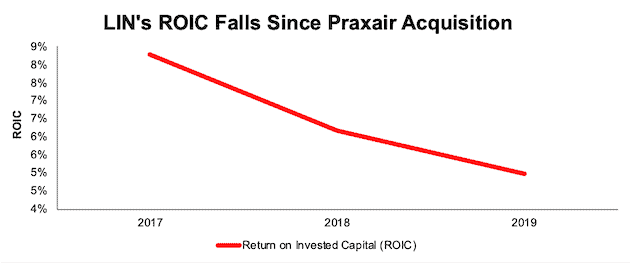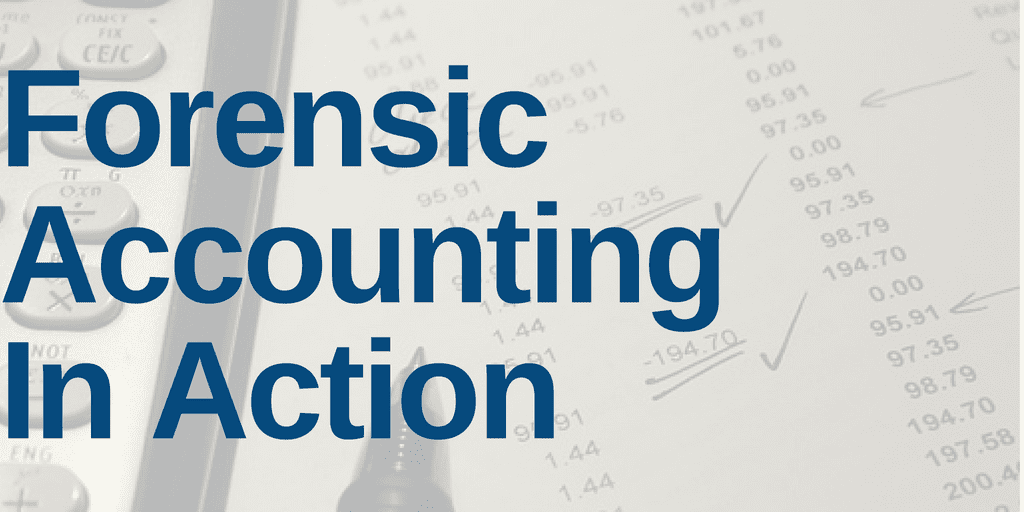Our latest featured stock is an industrial gas company with distorted GAAP net income due to the impact of a recent acquisition. Last week, we analyzed 501 10-Ks and 10-Qs.
Analyst Robert Hicks found an unusual item in Linde, PLC’s (LIN) 2019 10-K.
On Page 19, LIN discloses $2.0 billion in unusual expenses hidden in GAAP net income. These expenses stem from the purchase accounting impact of the merger between Praxair and Linde AG in October 2018. After adjusting for all hidden and reported items, we find that LIN’s core earnings[1] were $3.9 billion in 2019 compared to GAAP net income of $2.3 billion.
While the merger increased LIN’s core earnings from $1.8 billion in 2018 to $3.9 billion in 2019, it has failed to create true shareholder value given the purchase price. LIN’s invested capital increased from $23 billion in the year before the merger to $81 billion in 2019. As a result of invested capital nearly quadrupling, while profits only doubled, the company’s return on invested capital (ROIC) fell from 8% the year before the merger to 5% in 2019. LIN has yet to realize the “anticipated annual synergies and cost reductions” in a way that creates shareholder value.
Figure 1: LIN’s ROIC Since Acquiring Praxair in 2018

Sources: New Constructs, LLC and company filings
LIN’s understated earnings in 2019 earn the stock our “Beat” Earnings Distortion Score (as featured on CNBC Squawk Box), which means LIN is more likely to beat consensus expectations. Despite the likelihood to beat expectations in the short-term, LIN’s low ROIC and expensive stock means the stock earns our Unattractive Risk/Reward rating. In other words, the stock does not represent attractive risk/reward over the long-term.
Other Critical Details on LIN Found by Our Robo-Analyst Technology
Balance Sheet: we made $12.6 billion of adjustments to calculate invested capital with a net increase of $7.1 billion. One of the most notable adjustments was $4.8 billion (6% of reported net assets) in other comprehensive income. See all adjustments to LIN’s balance sheet here.
Valuation: we made $29.5 billion of adjustments with a net effect of decreasing shareholder value by $24.9 billion. Apart from $15 billion in total debt, which includes operating leases, the most notable adjustment to shareholder value was $6.6 billion in deferred tax liabilities. This adjustment represents 6% of LIN’s market cap. See all adjustments to LIN’s valuation here.
The Power of the Robo-Analyst
We analyzed 501 10-K and 10-Q filings last week, from which our Robo-Analyst[2] technology collected 55,615 data points. Our analyst team made 9,915 forensic accounting adjustments with a dollar value of $2.9 trillion. The adjustments were applied as follows:
- 3,482 income statement adjustments with a total value of $164 billion
- 4,342 balance sheet adjustments with a total value of $1.1 trillion
- 2,091 valuation adjustments with a total value of $1.6 trillion
Figure 2: Filing Season Diligence for the Week of March 2 – March 8

Sources: New Constructs, LLC and company filings.
Every year in this six-week stretch from mid-February through the end of March, we parse and analyze roughly 2,000 10-Ks to update our models for companies with 12/31 and 1/31 fiscal year ends. This effort is made possible by the combination of expertly trained human analysts with our “Robo-Analyst.” Featured by Bloomberg and Harvard Business School in “Disrupting Fundamental Analysis with Robo-Analysts”, our research automation technology uses machine learning and natural language processing to automate and improve financial modeling.
No Substitute for Diligence on Fundamentals
Our technology enables us to deliver diligence on fundamentals at a previously impossible scale. We believe this research is necessary to uncover the true profitability of a firm and make sound investment decisions. “Core Earnings: New Data and Evidence,” a recent paper from professors at Harvard Business School and MIT Sloan, shows how our adjustments create a measure of core earnings that is more predictive of future earnings than comparable metrics from Compustat and IBES.
Only by reading through the footnotes and making adjustments to reverse accounting distortions can investors and advisors alike get beyond the noise and get the truth about earnings and valuation.
This article originally published on March 10, 2020.
Disclosure: David Trainer, Robert Hicks, Kyle Guske II, and Matt Shuler receive no compensation to write about any specific stock, sector, style, or theme.
Follow us on Twitter (#filingseasonfinds), Facebook, LinkedIn, and StockTwits for real-time alerts on all our research.
[1] Our Core earnings are a superior measure of profits, as demonstrated in In Core Earnings: New Data & Evidence a paper by professors at Harvard Business School (HBS) & MIT Sloan. The paper empirically shows that our data is superior to IBES “Street Earnings”, owned by Blackstone (BX) and Thomson Reuters (TRI), and “Income Before Special Items” from Compustat, owned by S&P Global (SPGI).
[2] Harvard Business School features the powerful impact of our research automation technology in the case New Constructs: Disrupting Fundamental Analysis with Robo-Analysts.
